6G-Enabled Smart Agriculture: A Review and Prospect
Abstract
:1. Introduction
- We introduce the history of agriculture and the concept of smart agriculture.
- We review several wireless communication technologies widely used in agriculture and their specific application scenarios and cases in agriculture.
- We introduce several up-to-date 6G technologies and discuss their characteristics, advantages, and limitations from the perspective of agriculture. Then, we survey the current applications in agriculture activities from the existing literature. Furthermore, the potential applications of 6G technologies in agriculture are also envisaged.
| Name | The Beginning Period | Features |
|---|---|---|
| Agri 1.0 [6] | 16th Century | The labor force is mainly human and animal, and the means of production are inferior. This has led to small farms and low levels of production. |
| Agri 2.0 [7] | 1765 | The upgrading of the steam engine leads to the mechanization of agricultural tools, which significantly increases productivity. |
| Agri 3.0 [8] | 1992 | Information and communication technologies begin to be used in agriculture. The production and cultivation of agriculture is partially automated. |
| Agri 4.0 [9] | 2017 | Advanced information and communication technologies (Artificial Intelligence) are being used in-depth in agriculture, with agricultural cultivation and production becoming highly unmanned and intelligent. |
2. Mature Wireless Communication Technologies Used in Agriculture
2.1. ZigBee
2.2. LoRa
2.3. Wi-Fi
2.4. Bluetooth
3. 6G and Its Associated Technologies in Agriculture
3.1. Space–Air–Ground-Integrated Networks
- (1)
- Island farm communications: Island farms are generally in remote areas and operate on a large scale. Deploying base stations and other communication network infrastructure is costly and unprofitable, whereas air–ground-integrated networks are suitable for remote areas and large areas.
- (2)
- Implementing large-scale and complex agricultural activities: Agricultural production and cultivation activities inevitably tend to be large-scale and complex, and it is challenging to satisfy large-scale and complex agricultural activities with ground networks alone, while air–air–ground-integrated networks intelligently integrate ground communication networks, drones, and satellites to flexibly build communication networks that fully meet the needs of large-scale and highly complex agricultural activities.
- (3)
- Forest protection: Forests generally cover large areas and are located in remote areas with complex terrain. Solely using ground-based infrastructures to provide full coverage in forests is not only costly, but also inefficient. A deep combination of drone and satellite networks can support the wireless sensor networks for monitoring in forests, thus preventing incidents such as forest fires.
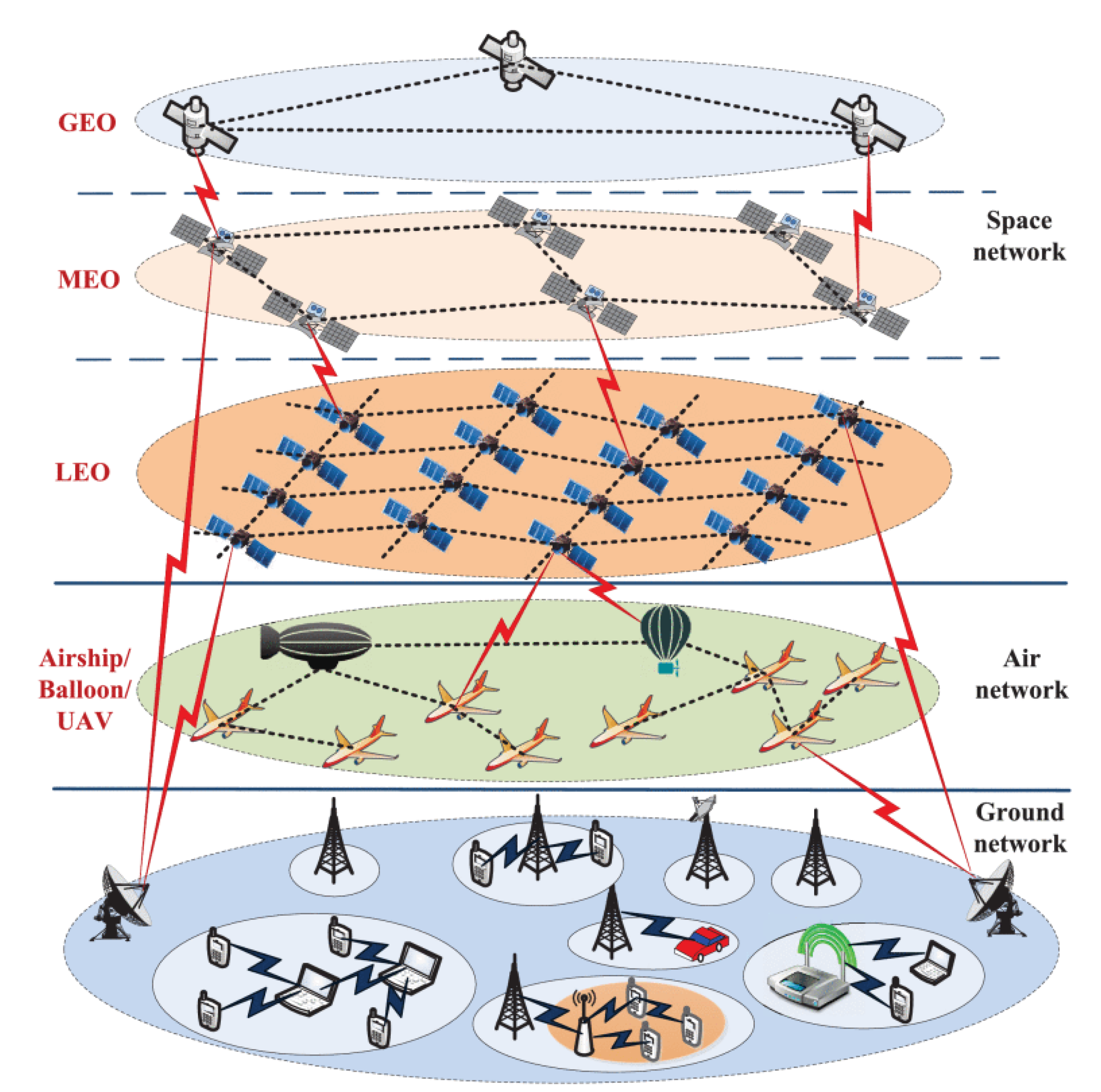
3.2. Terahertz Technology
- (1)
- Pest detection: Terahertz waves, which typically have a wavelength of a few picometres, are very suitable for wireless sensing because of their high penetration capacity and low energy consumption. Terahertz waves can be used to detect plant pests and thus prevent plant diseases.
- (2)
- Food safety detection: Terahertz spectroscopy has the potential to identify weak intermolecular interactions. It can be used to detect heavy metal substances that are generally contained in pesticides. Therefore, it is very appropriate to use terahertz waves to detect pesticide residues, as well as heavy metals, in food.
- (3)
- Water quality monitoring: Substances dissolved in water show unique physical characteristics. When radiated in a terahertz field, special spectral imprints may be observed. Thus, terahertz waves can be used to detect water contamination.
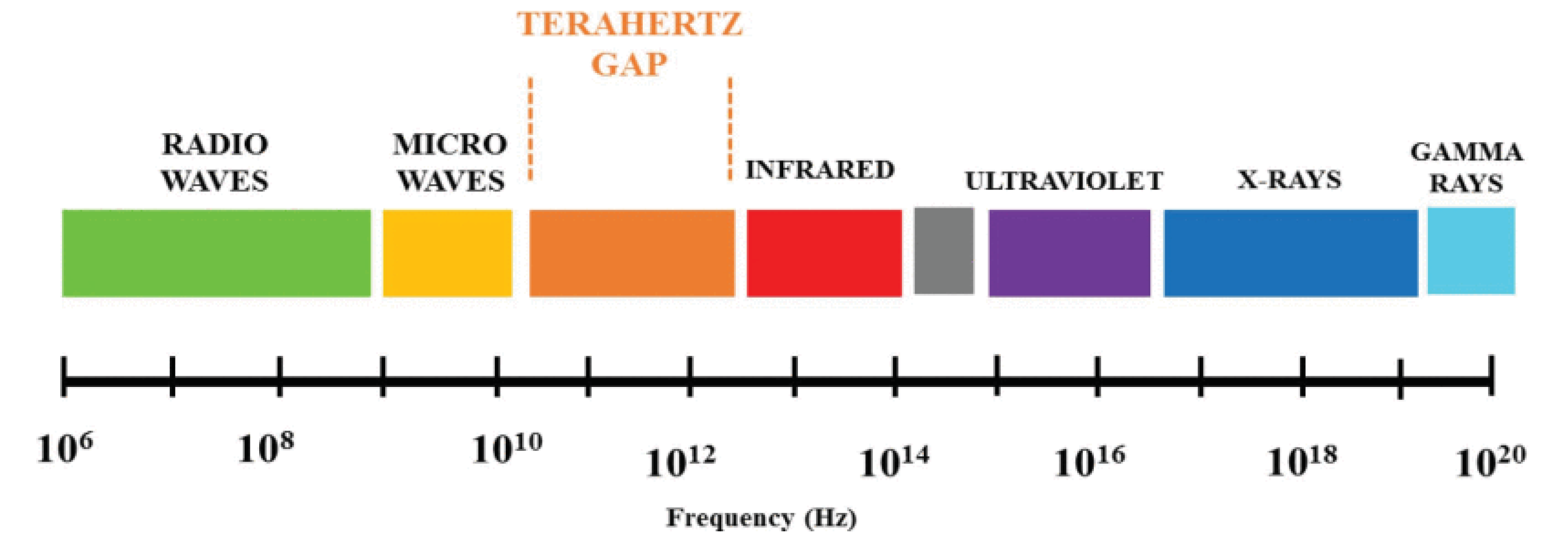
3.3. Reconfigurable Intelligent Surface (RIS)
- (1)
- Communications in remote areas: It is not cost-effective to densely deploy communications infrastructure such as base stations in remote rural areas. Instead, an RIS can improve the coverage and quality of service of communication systems by adjusting the propagation environment, with a low cost for deployment and maintenance. Therefore, an RIS is very suitable for aiding communication in rural areas.
- (2)
- Agricultural precision sensing: An RIS can increase the number of communication links, thus improving the accuracy of wireless sensing, with low cost and easy deployment. Therefore, an RIS is very suitable for precise agricultural sensing activities.
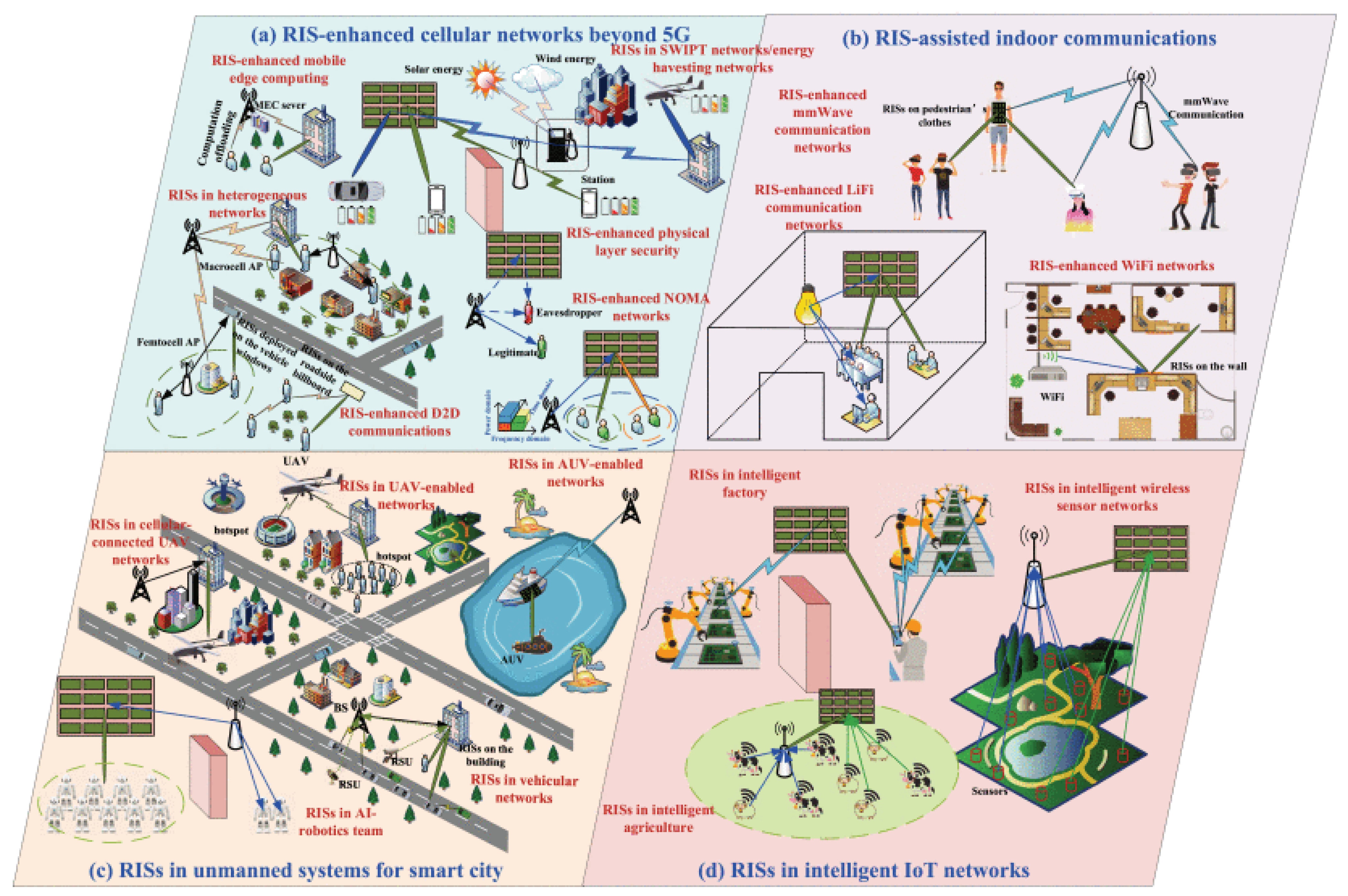
3.4. Wireless AI
- (1)
- Resource allocation optimization: AI-based scheduling of wireless resources is crucial to developing low-power and green agriculture. Using AI to allocate wireless resources will lead to more efficient resource usage, thus improving the efficiency of wireless agricultural sensors and reducing power consumption.
- (2)
- Optimization of wireless network architecture: In the future, by introducing Artificial Intelligence, networks will learn to make autonomous decisions and evolve according to application scenarios and requirements. The network architecture will also be more flexible in its deployment, thus increasing the efficiency of the network and achieving energy savings, load balancing, and coverage optimization. Such a network will improve the level of agricultural cultivation and production systems and drive agricultural activities to be intelligent and green.
- (3)
- AI-based wireless sensing: In agricultural fields or greenhouses, it is difficult to find out the detailed distribution of crops by image recognition due to the dense foliage of crops or other factors. In contrast, wireless sensing is not seriously affected by these factors and is therefore more suitable for locating crops. The combination of AI and wireless positioning can effectively improve positioning accuracy.
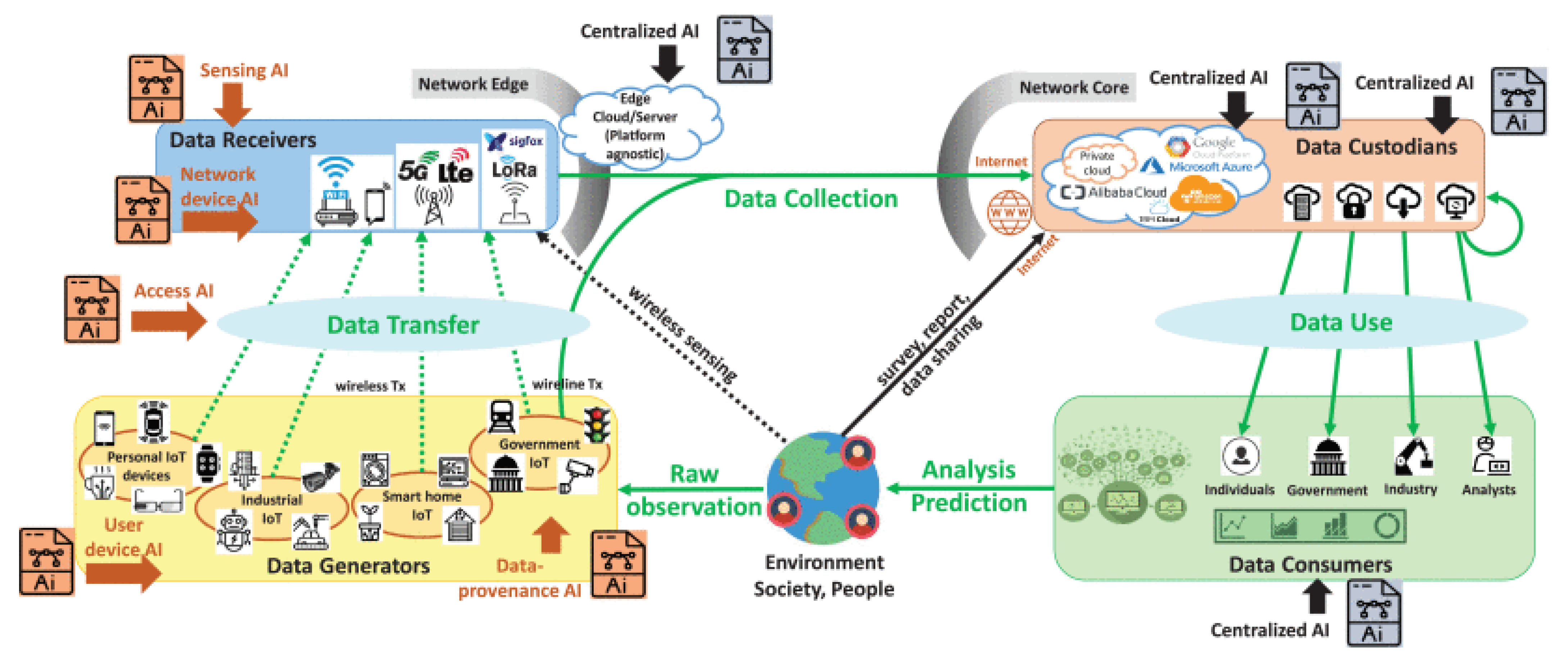
3.5. Integrated Sensing and Communications (ISAC)
- (1)
- The application of millimeter wave technology to ISAC systems improves the communication and sensing capabilities of the system, thus increasing its potential for usage in agriculture. A good example is the prevention of plant diseases, where cameras may not be able to capture pests in greenhouses or farm fields due to the shading of crop leaves. Non-optical imaging technologies, such as millimeter wave imaging, have a high penetration capacity and can penetrate foliage to detect pests and thus prevent crop infestations early. Another example is in dairy farming. Currently, millimeter wave technology can be used to monitor animal behavior with high accuracy, and it has the advantage of non-visual distance. Meanwhile, the communications function of millimeter wave-based ISAC systems can support the transfer of the monitoring data such as alert messages for abnormal animal behavior and images/videos of the pests.
- (2)
- ISAC with space–air–ground-integrated networks can be far more effective in some agricultural applications than those solely based on terrestrial networks. Forest protection is one typical application. Forests are generally large-scale and located in rural areas. Space–air–ground-integrated networks are an efficient approach to provide communications service. Moreover, plants always shade each other. Hence, it would be costly and of high energy consumption to solely rely on cameras for monitoring. Sensing with space–air–ground-integrated networks allows for the comprehensive monitoring and early spotting of forest anomalies.
3.6. Massive MIMO

3.7. Digital Twins
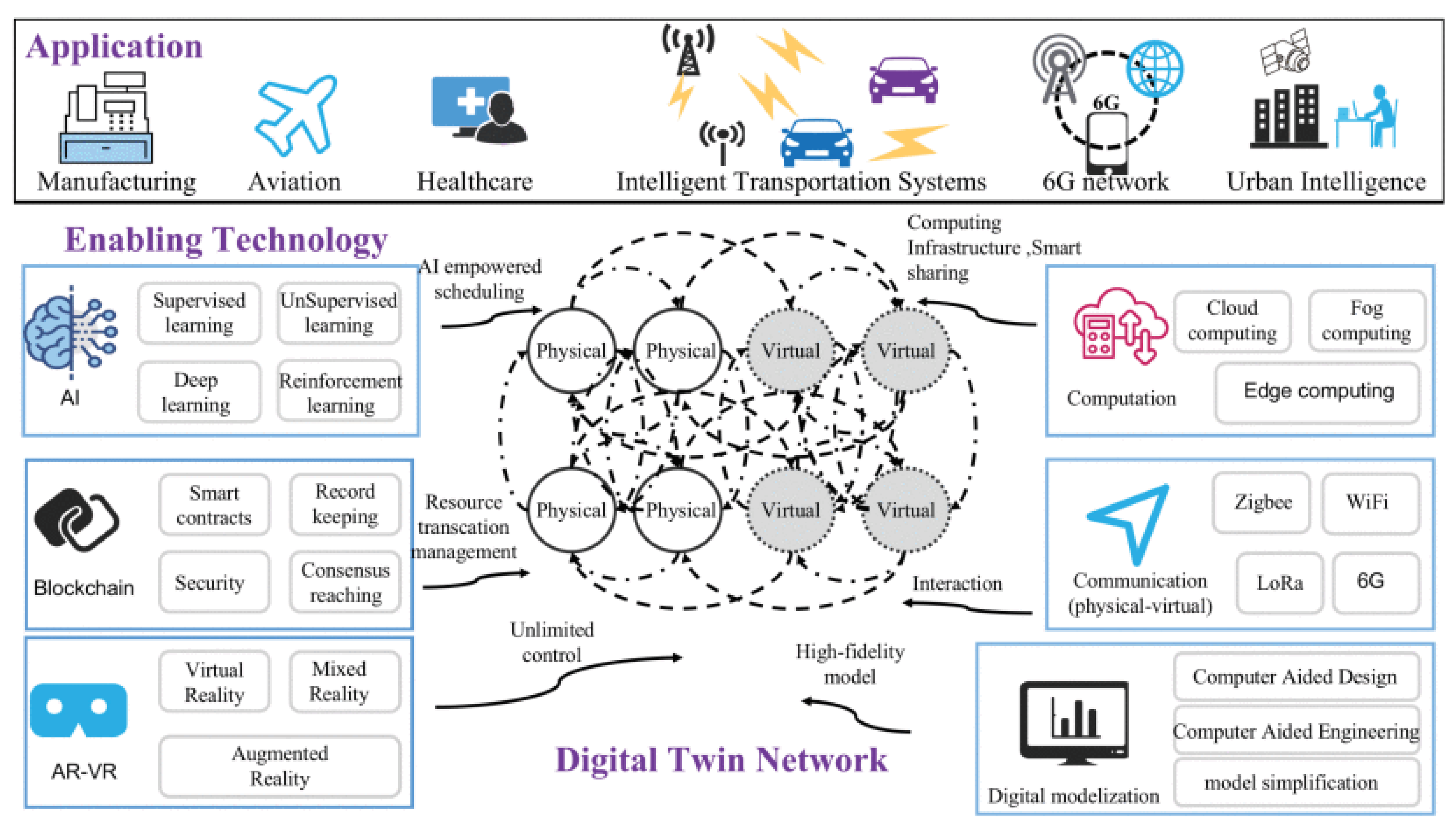
3.8. Ambient Backscatter Communications
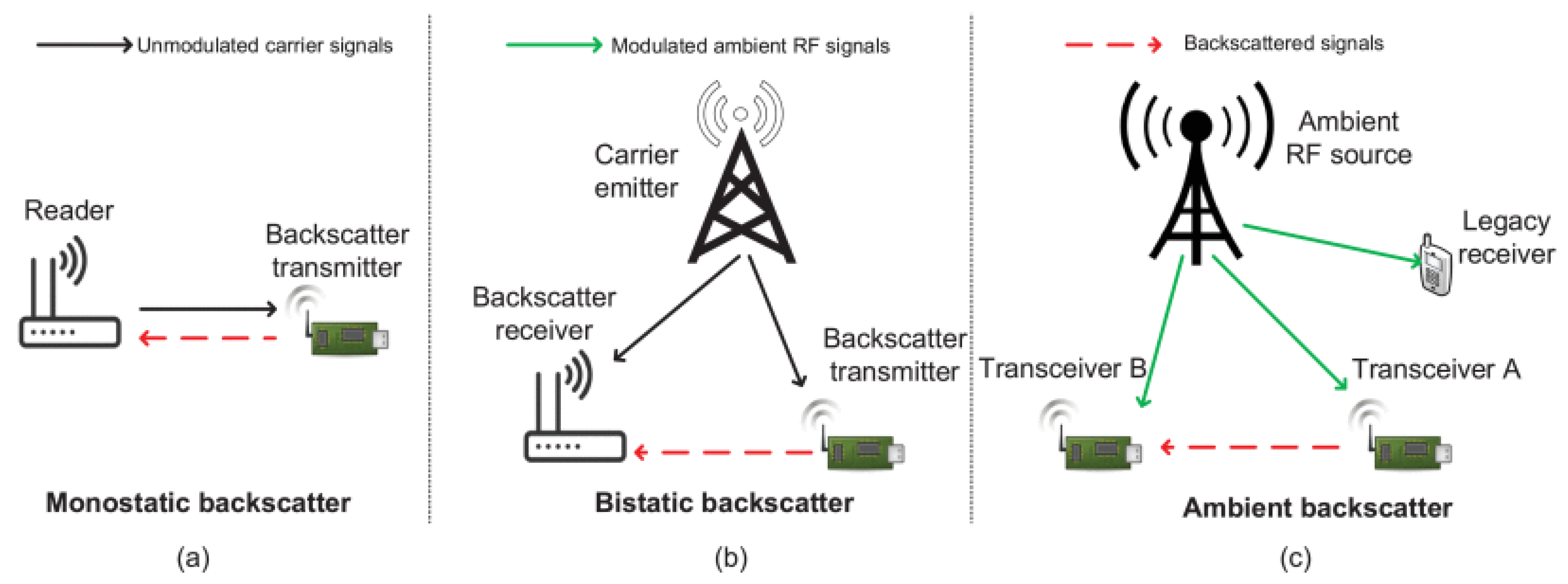
4. Conclusions
Author Contributions
Funding
Acknowledgments
Conflicts of Interest
Abbreviations
| SAGIN | Space–air–ground-integrated networks |
| RIS | Reconfigurable intelligent surfaces |
| AI | Artificial Intelligence |
| ISAC | Integrated sensing and communication |
| MIMO | Multiple-input multiple-output |
| UAV | Unmanned aerial vehicle |
| IoT | Internet of Things |
| Wi-Fi | Wireless fidelity |
| DT | Digital twins |
References
- Abbasi, R.; Martinez, P.; Ahmad, R. The digitization of agricultural industry—A systematic literature review on agriculture 4.0. Smart Agric. Technol. 2022, 2, 100042. [Google Scholar] [CrossRef]
- Yang, X.; Shu, L.; Chen, J. A survey on smart agriculture: Development modes, technologies, and security and privacy challenges. IEEE/CAA. J. Autom. Sin. 2021, 8, 273–302. [Google Scholar] [CrossRef]
- Hidayat, T.; Mahardiko, R.; Tigor, F.D.S. Method of systematic literature review for internet of things in zigbee smart agriculture. In Proceedings of the 2020 8th International Conference on Information and Communication Technology (ICoICT), Bandung, Indonesia, 24–26 June 2020; pp. 1–4. [Google Scholar]
- Qazi, S.; Khawaja, B.A.; Farooq, Q.U. IoT-equipped and AI-enabled next generation smart agriculture: A critical review, current challenges and future trends. IEEE Access 2022, 10, 21219–21235. [Google Scholar] [CrossRef]
- Zhai, Z.; Martínez, J.F.; Beltran, V. Decision support systems for agriculture 4.0: Survey and challenges. Comput. Electron. Agric. 2020, 170, 105256. [Google Scholar] [CrossRef]
- Klerkx, L.; Rose, D. Dealing with the game-changing technologies of Agriculture 4.0: How do we manage diversity and responsibility in food system transition pathways? Glob. Food Secur. 2020, 24, 100347. [Google Scholar] [CrossRef]
- Sinha, B.B.; Dhanalakshmi, R. Recent advancements and challenges of Internet of Things in smart agriculture: A survey. Future Gener. Comput. Syst. 2022, 126, 169–184. [Google Scholar] [CrossRef]
- Liu, Y.; Ma, X.; Shu, L. From Industry 4.0 to Agriculture 4.0: Current status, enabling technologies, and research challenges. IEEE Trans. Ind. Inform. 2020, 17, 4322–4334. [Google Scholar] [CrossRef]
- Rahmann, G.; Reza, A.M.; Bàrberi, P. Organic Agriculture 3.0 is innovation with research. Org. Agric. 2017, 7, 169–197. [Google Scholar] [CrossRef]
- Yang, Z.; Chen, M.; Wong, K.K. Federated learning for 6G: Applications, challenges, and opportunities. Engineering 2021, 8, 33–41. [Google Scholar] [CrossRef]
- Khelifa, B.; Amel, D.; Amel, B. Smart irrigation using internet of thing. In Proceedings of the 2015 Fourth International Conference on Future Generation Communication Technology (FGCT), Luton, UK, 29–31 July 2015; pp. 1–6. [Google Scholar]
- de Oliveira, K.V.; Castelli, H.M.E.; Montebeller, S.J. Wireless sensor network for smart agriculture using ZigBee protocol. In Proceedings of the 2017 IEEE First Summer School on Smart Cities (S3C), Maceió, Brazil, 6–11 August 2017; pp. 61–66. [Google Scholar]
- Suji Prasad, S.J.; Thangatamilan, M.; Suresh, M. An efficient LoRa-based smart agriculture management and monitoring system using wireless sensor networks. Int. J. Ambient. Energy 2021, 2, 1–4. [Google Scholar] [CrossRef]
- Yim, D.; Chung, J.; Cho, Y. An experimental LoRa performance evaluation in tree farm. In Proceedings of the 2018 IEEE Sensors Applications Symposium (SAS), Karlsruhe, Germany, 12–14 March 2018; pp. 1–6. [Google Scholar]
- Nisa, N.A.B.; Priyadharshini, K.; Priyadharshini, K. Agriculture irrigation water demand forecasting using lora technology. Int. Res. J. Eng. Technol. 2019, 6, 3050–3052. [Google Scholar]
- Ofori-Dwumfuo, G.O.; Salakpi, S.V. WiFi and WiMAX deployment at the Ghana Ministry of Food and Agriculture. Res. J. Appl. Sci. Eng. Technol. 2011, 3, 1374–1383. [Google Scholar]
- Wang, J.; Sun, Q.; Shang, J. A new approach for estimating soil salinity using a low-cost soil sensor in situ: A case study in saline regions of China’s East Coast. Remote Sens. 2020, 12, 239. [Google Scholar] [CrossRef]
- Chazarra-Zapata, J.; Parras-Burgos, D.; Arteaga, C. Adaptation of a traditional irrigation system of micro-plots to smart agri development: A case study in harac (Spain). Agronomy 2020, 10, 1365. [Google Scholar] [CrossRef]
- Asha, K.; Sakthi, S.; Manisha, S. Bluetooth Embedded Robotic with Agriculture Seeding, Plowing and Grass Cutting Powered by Solar Energy; New Horizon College of Engineering: Bengaluru, India, 2020; p. 13198. [Google Scholar]
- Romanov, V.; Galelyuka, I.; Voronenko, O. Smart Sensors and Computer Devices for Agriculture, Food Production Process Control and Medicine. In Proceedings of the 2019 29th International Conference on Computer Theory and Applications (ICCTA), Alexandria, Egypt, 29–31 October 2019; pp. 1–4. [Google Scholar]
- Happila, T.; Pandiaraj, K.; Thilagaraj, M. Sensor Based Quality and Safety Ensured Agriculture Followed by Neural Network Based Plant Disease Management. Ann. Rom. Soc. Cell Biol. 2021, 25, 2524–2528. [Google Scholar]
- Ramya, C.M.; Shanmugaraj, M.; Prabakaran, R. Study on ZigBee technology. In Proceedings of the 2011 3rd International Conference on Electronics Computer Technology, Nagpur, India, 8–10 April 2011; pp. 297–301. [Google Scholar]
- Lin, Y.G. An intelligent monitoring system for agriculture based on ZigBee wireless sensor networks. In Advanced Materials Research; Trans Tech Publications Ltd.: Bäch SZ, Switzerland, 2012; Volume 383, pp. 4358–4364. [Google Scholar]
- Xiang, X. Design of fuzzy drip irrigation control system based on zigbee wireless sensor network. In Proceedings of the International Conference on Computer and Computing Technologies in Agriculture, Nanchang, China, 13–15 May 2010; pp. 495–501. [Google Scholar]
- Ding, X.; Xiong, G.; Hu, B. Environment monitoring and early warning system of facility agriculture based on heterogeneous wireless networks. In Proceedings of the 2013 IEEE International Conference on Service Operations and Logistics, and Informatics, Beijing, China, 28–30 July 2013; pp. 1–6. [Google Scholar]
- Saari, M.; bin Baharudin, A.M.; Sillberg, P. LoRa—A survey of recent research trends. In Proceedings of the 2018 41st International Convention on Information and Communication Technology, Electronics and Microelectronics (MIPRO), Pula, Croatia, 21–25 May 2018; pp. 1–8. [Google Scholar]
- Ma, Y.W.; Chen, J.L. Toward intelligent agriculture service platform with lora-based wireless sensor network. In Proceedings of the 2018 IEEE International Conference on Applied System Invention (ICASI), Tainan, Taiwan, 13–17 April 2018; pp. 1–7. [Google Scholar]
- Swain, M.; Zimon, D.; Singh, R. LoRa-LBO: An experimental analysis of LoRa link budget optimization in custom build IoT test bed for agriculture 4.0. Agronomy 2021, 11, 820. [Google Scholar] [CrossRef]
- Yang, Y. Design and application of intelligent agriculture service system with LoRa-based on wireless sensor network. In Proceedings of the 2020 International Conference on Computer Engineering and Application (ICCEA), Wuhan, China, 18–20 March 2020; pp. 712–716. [Google Scholar]
- Adame, T.; Carrascosa-Zamacois, M.; Bellalta, B. Time-sensitive networking in IEEE 802.11 be: On the way to low-latency WiFi 7. Sensors 2021, 21, 4954. [Google Scholar] [CrossRef]
- Kulkarni, J. Wideband cpw-fed oval-shaped monopole antenna for wi-fi5 and wi-fi6 applications. Prog. Electromagn. Res. C 2021, 107, 173–182. [Google Scholar] [CrossRef]
- Kulkarni, J.; Deshpande, V. Low-Profile, Compact, Two Port MIMO Antenna Conforming Wi-Fi-5/Wi-Fi-6/V2X/DSRC/INSAT-C for Wireless Industrial Applications. In Proceedings of the 2020 IEEE 17th India Council International Conference (INDICON), Delhi, India, 10–13 December 2020; pp. 1–5. [Google Scholar]
- Lloret, J.; Sendra, S.; García-Fernández, J. A WiFi-Based Sensor Network for Flood Irrigation Control in Agriculture. Electronics 2021, 10, 2454. [Google Scholar] [CrossRef]
- Ahmed, N.; De, D.; Hussain, I. Internet of Things (IoT) for smart precision agriculture and farming in rural areas. IEEE Internet Things J. 2018, 5, 4890–4899. [Google Scholar] [CrossRef]
- Li, L.; Xiaoguang, H.; Ke, C. The applications of wifi-based wireless sensor network in internet of things and smart grid. In Proceedings of the 2011 6th IEEE Conference on Industrial Electronics and Applications, Beijing, China, 21–23 June 2011; pp. 1–9. [Google Scholar]
- Bisdikian, C. An overview of the Bluetooth wireless technology. IEEE Commun. Mag. 2001, 39, 86–94. [Google Scholar] [CrossRef]
- Shaobo, Y.; Zhenjianng, C.; Xuesong, S. The appliacation of haracter module on the agriculture expert System. In Proceedings of the 2010 2nd International Conference on Industrial and Information Systems, Dalian, China, 10–11 July 2010; pp. 109–112. [Google Scholar]
- Bjarnason, J. Evaluation of Bluetooth low energy in agriculture environments. DiVA 2017, 1, 1–57. [Google Scholar]
- Janokar, S.G.; Kulkarni, N.K.; Datey, S.S. Bluetooth Controlled Agricultural Bot. In Proceedings of the 2019 International Conference on Nascent Technologies in Engineering (ICNTE), Mumbai, India, 4–5 January 2019; pp. 1–5. [Google Scholar]
- Salameh, A.I.; El Tarhuni, M. From 5G to 6G—Challenges, Technologies, and Applications. Future Internet 2022, 14, 117. [Google Scholar] [CrossRef]
- Wang, Z.; Du, Y.; Wei, K. Vision, application scenarios, and key technology trends for 6G mobile communications. Sci. China Inf. Sci. 2022, 65, 151301. [Google Scholar] [CrossRef]
- Liu, F.; Cui, Y.; Masouros, C. Integrated sensing and communications: Towards dual-functional wireless networks for 6G and beyond. IEEE J. Sel. Areas Commun. 2022, 40, 1728–1767. [Google Scholar] [CrossRef]
- Lu, W.; Mo, Y.; Feng, Y. Secure Transmission for Multi-UAV-Assisted Mobile Edge Computing Based on Reinforcement Learning. IEEE Trans. Netw. Sci. Eng. 2022, 1, 1–12. [Google Scholar] [CrossRef]
- Lu, W.; Ding, Y.; Gao, Y. Secure NOMA-Based UAV-MEC Network Towards a Flying Eavesdropper. IEEE Trans. Commun. 2022, 70, 3364–3376. [Google Scholar] [CrossRef]
- Lu, W.; Ding, Y.; Gao, Y. Resource and trajectory optimization for secure communications in dual unmanned aerial vehicle mobile edge computing systems. IEEE Trans. Ind. Inform. 2021, 18, 2704–2713. [Google Scholar] [CrossRef]
- Ray, P.P. A review on 6G for space-air-ground integrated network: Key enablers, open challenges, and future direction. J. King Saud Univ.-Comput. Inf. Sci. 2021, 4, 2–16. [Google Scholar] [CrossRef]
- Zhao, N.; Lu, W.; Sheng, M. UAV-assisted emergency networks in disasters. IEEE Wirel. Commun. 2019, 26, 45–51. [Google Scholar] [CrossRef]
- Kim, J.; Kim, S.; Ju, C. Unmanned aerial vehicles in agriculture: A review of perspective of platform, control, and applications. IEEE Access 2019, 7, 105100–105115. [Google Scholar] [CrossRef]
- Inoue, Y. Satellite-and drone-based remote sensing of crops and soils for smart farming—A review. Soil Sci. Plant Nutr. 2020, 66, 798–810. [Google Scholar] [CrossRef]
- Smith, W.L. Atmospheric soundings from satellites—False expectation or the key to improved weather prediction? Q. J. R. Meteorol. Soc. 1991, 117, 267–297. [Google Scholar]
- Yang, C.; Everitt, J.H.; Du, Q. Using high-resolution airborne and satellite imagery to assess crop growth and yield variability for precision agriculture. Proc. IEEE 2012, 101, 582–592. [Google Scholar] [CrossRef]
- Feiyang, Z.; Yueming, H.U.; Yingkai, X.I.E. Design of integrated space-air-ground farmland quality monitoring mobile laboratory. J. Agric. Resour. Environ. 2021, 38, 1029–1038. [Google Scholar]
- Almalki, F.A.; Soufiene, B.O.; Alsamhi, S.H. A low-cost platform for environmental smart farming monitoring system based on IoT and UAVs. Sustainability 2021, 13, 5908. [Google Scholar] [CrossRef]
- Mengen, D.; Montzka, C.; Jagdhuber, T. The SARSense campaign: Air-and space-borne C-and L-band SAR for the analysis of soil and plant parameters in agriculture. Remote Sens. 2021, 13, 825. [Google Scholar] [CrossRef]
- Fourati, F.; Alsamhi, S.H.; Alouini, M.S. Bridging the Urban-Rural Connectivity Gap through Intelligent Space, Air, and Ground Networks. arXiv 2022, arXiv:2202.12683. [Google Scholar]
- Liu, J.; Shi, Y.; Fadlullah, Z.M.; Kato, N. Space-Air-Ground Integrated Network: A Survey. IEEE Commun. Surv. Tutor. 2018, 20, 2714–2741. [Google Scholar] [CrossRef]
- Cherry, S. Edholm’s law of bandwidth. IEEE Spectr. 2004, 41, 58–60. [Google Scholar] [CrossRef]
- Rappaport, T.S.; Xing, Y.; Kanhere, O. Wireless communications and applications above 100 GHz: Opportunities and challenges for 6G and beyond. IEEE Access 2019, 7, 78729–78757. [Google Scholar] [CrossRef]
- Akyildiz, I.F.; Han, C.; Hu, Z. Terahertz band communication: An old problem revisited and research directions for the next decade. IEEE Trans. Commun. 2022, 70, 4250–4285. [Google Scholar] [CrossRef]
- Pan, S.; Xie, Y.; Chen, K. Obstacle Tracking Based on the Extended Kalman Filter and Millimeter-wave Radar. In Proceedings of the 2022 7th International Conference on Intelligent Computing and Signal Processing (ICSP), Xi’an, China, 15–17 April 2022; pp. 1770–1775. [Google Scholar]
- Zahid, A.; Yang, K.; Heidari, H. Terahertz haracterization of living plant leaves for quality of life assessment applications. In Proceedings of the 2018 Baltic URSI Symposium (URSI), Warsaw, Poland, 15–17 May 2018; pp. 117–120. [Google Scholar]
- Usman, M.; Ansari, S.; Taha, A. Terahertz-Based Joint Communication and Sensing for Precision Agriculture: A 6G Use-Case. Front. Commun. Netw. 2022, 3, 836506. [Google Scholar] [CrossRef]
- Wedage, L.T.; Butler, B.; Balasubramaniam, S. Climate change sensing through terahertz communications: A disruptive application of 6G networks. arXiv 2021, arXiv:2110.03074. [Google Scholar]
- Jiang, Y.Y.; Ge, H.Y.; Lian, F.Y. Application of THz technology to nondestructive detection of agricultural product quality. Guang Pu Xue Yu Guang Pu Fen Xi = Guang Pu 2014, 34, 2047–2052. [Google Scholar]
- Ghafoor, S.; Boujnah, N.; Rehmani, M.H.; Davy, A. MAC Protocols for Terahertz Communication: A Comprehensive Survey. IEEE Commun. Surv. Tutor. 2020, 22, 2236–2282. [Google Scholar] [CrossRef]
- Hu, X.; Zhong, C.; Zhu, Y. Programmable metasurface-based multicast systems: Design and analysis. IEEE J. Sel. Areas Commun. 2020, 38, 1763–1776. [Google Scholar] [CrossRef]
- Rao, L.; Zhang, Y.; Zhong, C. Resource Allocation and Beamforming Optimization for IRS-Assisted OFDMA Uplink in C-RAN. IEEE Commun. Lett. 2022, 1, 1–7. [Google Scholar] [CrossRef]
- Zhang, Y.; Wu, X.; Peng, H. Beamforming and fronthaul compression design for intelligent reflecting surface aided cloud radio access networks. Front. Inf. Technol. Electron. Eng. 2022, 23, 31–46. [Google Scholar] [CrossRef]
- Zhang, Y.; He, X.; Zhong, C. Fronthaul compression and beamforming optimization for uplink C-RAN with intelligent reflecting surface-enhanced wireless fronthauling. IEEE Commun. Lett. 2021, 25, 1979–1983. [Google Scholar] [CrossRef]
- Zhang, Y.; Zhong, C.; Zhang, Z. Sum rate optimization for two way communications with intelligent reflecting surface. IEEE Commun. Lett. 2020, 24, 1090–1094. [Google Scholar] [CrossRef]
- Hu, X.; Zhong, C.; Zhang, Y. Location information aided multiple intelligent reflecting surface systems. IEEE Trans. Commun. 2020, 68, 7948–7962. [Google Scholar] [CrossRef]
- Huang, C.; Yang, Z.; Alexandropoulos, G.C. Multi-hop RIS-empowered terahertz communications: A DRL-based hybrid beamforming design. IEEE J. Sel. Areas Commun. 2021, 39, 1663–1677. [Google Scholar] [CrossRef]
- Zhang, J.; Zhang, Y.; Zhong, C. Robust design for intelligent reflecting surfaces assisted MISO systems. IEEE Commun. Lett. 2020, 24, 2353–2357. [Google Scholar] [CrossRef]
- Liu, Y.; Li, D.; Du, B. Rethinking Sustainable Sensing in Agricultural Internet of Things: From Power Supply Perspective. IEEE Wirel. Commun. 2022, 3, 1–8. [Google Scholar] [CrossRef]
- Pan, C. Reconfigurable Intelligent Surfaces for 6G Systems: Principles, Applications, and Research Directions. IEEE Commun. Mag. 2021, 59, 14–20. [Google Scholar] [CrossRef]
- Zhuang, Y.; Wu, F.; Chen, C. Challenges and opportunities: From big data to knowledge in AI 2.0. Front. Inf. Technol. Electron. Eng. 2017, 18, 3–14. [Google Scholar] [CrossRef]
- Elsayed, M.; Erol-Kantarci, M. AI-enabled future wireless networks: Challenges, opportunities, and open issues. IEEE Veh. Technol. Mag. 2019, 14, 70–77. [Google Scholar] [CrossRef]
- Hur, S.; Baek, S.; Kim, B. Proposal on millimeter-wave channel modeling for 5G cellular system. IEEE J. Sel. Top. Signal Process. 2016, 10, 454–469. [Google Scholar] [CrossRef]
- Ye, H.; Li, G.Y.; Juang, B.H. Power of deep learning for channel estimation and signal detection in OFDM systems. IEEE Wirel. Commun. Lett. 2017, 7, 114–117. [Google Scholar] [CrossRef]
- Jiang, Y.; Kim, H.; Asnani, H. Turbo autoencoder: Deep learning based channel codes for point-to-point communication channels. Adv. Neural Inf. Process. Syst. 2019, 32, 1–8. [Google Scholar]
- Cammerer, S.; Gruber, T.; Hoydis, J. Scaling deep learning-based decoding of polar codes via partitioning. In Proceedings of the GLOBECOM 2017–2017 IEEE Global Communications Conference, Beijing, China, 4–8 December 2017; pp. 1–6. [Google Scholar]
- Zhao, Z.; Vuran, M.C.; Guo, F. Deep-waveform: A learned OFDM receiver based on deep complex-valued convolutional networks. IEEE J. Sel. Areas Commun. 2021, 39, 2407–2420. [Google Scholar] [CrossRef]
- Bourtsoulatze, E.; Kurka, D.B.; Gündüz, D. Deep joint source-channel coding for wireless image transmission. IEEE Trans. Cogn. Commun. Netw. 2019, 5, 567–579. [Google Scholar] [CrossRef]
- Jiang, P.; Wang, T.; Han, B. AI-Aided Online Adaptive OFDM Receiver: Design and Experimental Results. IEEE Trans. Wirel. Commun. 2021, 20, 7655–7668. [Google Scholar] [CrossRef]
- Elbir, A.M.; Papazafeiropoulos, A.K. Hybrid precoding for multiuser millimeter wave massive MIMO systems: A deep learning approach. IEEE Trans. Veh. Technol. 2019, 69, 552–563. [Google Scholar] [CrossRef]
- Gui, G.; Huang, H.; Song, Y. Deep learning for an effective nonorthogonal multiple access scheme. IEEE Trans. Veh. Technol. 2018, 67, 8440–8450. [Google Scholar] [CrossRef]
- Kim, W.; Lim, G.; Ahn, Y. Active user detection of machine-type communications via dimension spreading neural network. In Proceedings of the ICC 2019–2019 IEEE International Conference on Communications (ICC), Beijing, China, 20–24 May 2019; pp. 1–6. [Google Scholar]
- Aneesh, S.; Shaikh, D. Dynamic Repositioning of 6G Base Station Based on User Location Using AI. In Proceedings of the Dynamic Repositioning of 6G Base Station Based on User Location Using AI, Mumbai, India, 9 April 2022. [Google Scholar]
- Wei, Y.; Yu, F.R.; Song, M. User scheduling and resource allocation in HetNets with hybrid energy supply: An actor-critic reinforcement learning approach. IEEE Trans. Wirel. Commun. 2017, 17, 680–692. [Google Scholar] [CrossRef]
- Chen, M.; Saad, W.; Yin, C. Echo state networks for self-organizing resource allocation in LTE-U with uplink–downlink decoupling. IEEE Trans. Wirel. Commun. 2016, 16, 3–16. [Google Scholar] [CrossRef]
- Wang, J.; Ding, Y.; Bian, S. UL-CSI data driven deep learning for predicting DL-CSI in cellular FDD systems. IEEE Access 2019, 7, 96105–96112. [Google Scholar] [CrossRef]
- Huang, L.; Zhang, H.; Li, R. Reinforcement learning for nested polar code construction. In Proceedings of the 2019 IEEE Global Communications Conference (GLOBECOM), Beijing, China, 9–13 December 2019; pp. 1–6. [Google Scholar]
- Chinchali, S.; Hu, P.; Chu, T. Cellular network traffic scheduling with deep reinforcement learning. In Proceedings of the Thirty-Second AAAI Conference on Artificial Intelligence, New Orleans, LA, USA, 2–7 February 2018. [Google Scholar]
- Song, H.; Bai, J.; Yi, Y. Artificial intelligence enabled Internet of Things: Network architecture and spectrum access. IEEE Comput. Intell. Mag. 2020, 15, 44–51. [Google Scholar] [CrossRef]
- Fan, C.; Li, B.; Zhao, C. Learning-based spectrum sharing and spatial reuse in mm-wave ultradense networks. IEEE Trans. Veh. Technol. 2017, 67, 4954–4968. [Google Scholar] [CrossRef]
- Xiao, L.; Li, Y.; Dai, C. Reinforcement learning-based NOMA power allocation in the presence of smart jamming. IEEE Trans. Veh. Technol. 2017, 67, 3377–3389. [Google Scholar] [CrossRef]
- Tanzil, S.M.S.; Hoiles, W.; Krishnamurthy, V. Adaptive scheme for caching YouTube content in a cellular network: Machine learning approach. IEEE Access 2017, 5, 5870–5881. [Google Scholar] [CrossRef]
- Yang, K.; Jiang, T.; Shi, Y. Federated learning via over-the-air computation. IEEE Trans. Wirel. Commun. 2020, 19, 2022–2035. [Google Scholar] [CrossRef]
- Torai, S.; Chiyoda, S.; Ohara, K. Application of AI technology to smart agriculture: Detection of plant diseases. In Proceedings of the 2020 59th Annual Conference of the Society of Instrument and Control Engineers of Japan (SICE), Fukuoka, Japan, 23–26 September 2020; pp. 1514–1519. [Google Scholar]
- Gupta, N.; Khosravy, M.; Patel, N. Economic data analytic AI technique on IoT edge devices for health monitoring of agriculture machines. Appl. Intell. 2020, 50, 3990–4016. [Google Scholar] [CrossRef]
- Dong, W.; Wu, T.; Sun, Y.; Luo, J. Digital mapping of soil available phosphorus supported by AI technology for precision agriculture. In Proceedings of the 2018 7th International Conference on Agro-Geoinformatics (Agro-Geoinformatics), Beijing, China, 6–9 August 2018; pp. 1–5. [Google Scholar]
- Idoje, G.; Dagiuklas, T.; Iqbal, M. Survey for smart farming technologies: Challenges and issues. Comput. Electr. Eng. 2021, 92, 107104. [Google Scholar] [CrossRef]
- Vijayakumar, V.; Balakrishnan, N. Artificial intelligence-based agriculture automated monitoring systems using WSN. J. Ambient. Intell. Humaniz. Comput. 2021, 12, 8009–8016. [Google Scholar] [CrossRef]
- Vincent, D.R.; Deepa, N.; Elavarasan, D. Sensors driven AI-based agriculture recommendation model for assessing land suitability. Sensors 2019, 19, 3667. [Google Scholar] [CrossRef]
- Dasgupta, I.; Saha, J.; Venkatasubbu, P. AI crop predictor and weed detector using wireless technologies: A smart application for farmers. Arab. J. Sci. Eng. 2020, 45, 11115–11127. [Google Scholar] [CrossRef]
- Somov, A.; Shadrin, D.; Fastovets, I. Pervasive agriculture: IoT-enabled greenhouse for plant growth control. IEEE Pervasive Comput. 2018, 17, 65–75. [Google Scholar] [CrossRef]
- Nguyen, D.C. Enabling AI in Future Wireless Networks: A Data Life Cycle Perspective. IEEE Commun. Surv. Tutor. 2021, 23, 553–595. [Google Scholar] [CrossRef]
- Tan, D.K.P.; He, J.; Li, Y. Integrated sensing and communication in 6G: Motivations, use cases, requirements, challenges and future directions. In Proceedings of the 2021 1st IEEE International Online Symposium on Joint Communications & Sensing (JC&S), Dresden, Germany, 23–24 February 2021; pp. 1–6. [Google Scholar]
- Quan, S.; Qian, W.; Guq, J.; Zhang, V. Radar-communication integration: An overview. In Proceedings of the 7th IEEE/International Conference on Advanced Infocomm Technology, Fuzhou, China, 14–16 November 2014; pp. 98–103. [Google Scholar]
- Araújo, D.C.; Maksymyuk, T.; de Almeida, A.L. Massive MIMO: Survey and future research topics. IET Commun. 2012, 10, 1938–1946. [Google Scholar] [CrossRef]
- Saleem, A.; Xu, Y.; Khan, R.A. Statistical Characteristics of 3D MIMO Channel Model for Vehicle-to-Vehicle Communications. Wirel. Commun. Mob. Comput. 2022, 2022, 9090494. [Google Scholar] [CrossRef]
- Saleem, A.; Cui, H.; He, Y. Channel Propagation Characteristics for Massive Multiple-Input/Multiple-Output Systems in a Tunnel Environment [Measurements Corner]. IEEE Antennas Propag. Mag. 2022, 64, 126–142. [Google Scholar] [CrossRef]
- Kulkarni, N.P.; Bahadure, N.B.; Patil, P.D. Flexible Interconnected 4-Port MIMO Antenna for Sub-6 GHz 5G and X Band Applications. AEU-Int. J. Electron. Commun. 2022, 152, 154243. [Google Scholar] [CrossRef]
- Kulkarni, N.P.; Bahadure, N.B.; Patil, P.D. Flexible MIMO Antennas for 5G Applications. In Proceedings of the 2022 10th International Conference on Emerging Trends in Engineering and Technology-Signal and Information Processing (ICETET-SIP-22), Nagpur, India, 29–30 April 2022; pp. 1–6. [Google Scholar]
- Kulkarni, J.; Han, T.Y.; Row, J.S. Multiband 4-Port DGS MIMO Antenna with DR Isolating Element for Wireless Applications. In Proceedings of the 2021 IEEE International Symposium on Antennas and Propagation and USNC-URSI Radio Science Meeting (APS/URSI), Trento, Italy, 4–10 December 2021; pp. 1021–1022. [Google Scholar]
- Liu, A. A Survey on Fundamental Limits of Integrated Sensing and Communication. IEEE Commun. Surv. Tutor. 2022, 24, 994–1034. [Google Scholar] [CrossRef]
- Chaudhary, D.D.; Nayse, S.P.; Waghmare, L.M. Application of wireless sensor networks for greenhouse parameter control in precision agriculture. Int. J. Wirel. Mob. Netw. (IJWMN) 2011, 3, 140–149. [Google Scholar] [CrossRef]
- Anisi, M.H.; Abdul-Salaam, G.; Abdullah, A.H. A survey of wireless sensor network approaches and their energy consumption for monitoring farm fields in precision agriculture. Precis. Agric. 2015, 16, 216–238. [Google Scholar] [CrossRef]
- Bana, A.S.; De Carvalho, E.; Soret, B. Massive MIMO for internet of things (IoT) connectivity. Phys. Commun. 2019, 37, 100859. [Google Scholar] [CrossRef]
- Zhao, J.; Gao, F.; Wu, Q. Beam tracking for UAV mounted SatCom on-the-move with massive antenna array. IEEE J. Sel. Areas Commun. 2018, 36, 363–375. [Google Scholar] [CrossRef] [Green Version]
- Albreem, M.A.; Juntti, M.; Shahabuddin, S. Massive MIMO Detection Techniques: A Survey. IEEE Commun. Surv. Tutor. 2019, 21, 3109–3132. [Google Scholar] [CrossRef]
- Jones, D.; Snider, C.; Nassehi, A. Characterising the Digital Twin: A systematic literature review. CIRP J. Manuf. Sci. Technol. 2020, 29, 36–52. [Google Scholar] [CrossRef]
- Barricelli, B.R.; Casiraghi, E.; Fogli, D. A survey on digital twin: Definitions, characteristics, applications, and design implications. IEEE Access 2019, 7, 167653–167671. [Google Scholar] [CrossRef]
- Angin, P.; Anisi, M.H.; Göksel, F. AgriLoRa: A digital twin framework for smart agriculture. Netw. Ubiquitous Comput. 2020, 11, 77–96. [Google Scholar]
- Ghandar, A.; Ahmed, A.; Zulfiqar, S. A decision support system for urban agriculture using digital twin: A case study with aquaponics. IEEE Access 2021, 9, 35691–35708. [Google Scholar] [CrossRef]
- Batty, M. Digital twins. Environ. Plan. B Urban Anal. City Sci. 2018, 45, 817–820. [Google Scholar] [CrossRef]
- Howard, D.A.; Ma, Z.; Aaslyng, J.M. Data architecture for digital twin of commercial greenhouse production. In Proceedings of the 2020 RIVF International Conference on Computing and Communication Technologies (RIVF), Budapest, Hungary, 14–15 October 2020; pp. 1–7. [Google Scholar]
- Jans-Singh, M.; Leeming, K.; Choudhary, R. Digital twin of an urban-integrated hydroponic farm. Data-Cent. Eng. 2020, 1, e20. [Google Scholar] [CrossRef]
- Autiosalo, J.; Vepsalainen, J.; Viitala, R.; Tammi, K. A Feature-Based Framework for Structuring Industrial Digital Twins. IEEE Access 2020, 8, 1193–1208. [Google Scholar] [CrossRef]
- Wu, W.; Wang, X.; Hawbani, A. A survey on ambient backscatter communications: Principles, systems, applications, and challenges. Comput. Netw. 2022, 216, 109235. [Google Scholar] [CrossRef]
- Daskalakis, S.N.; Georgiadis, A.; Goussetis, G. Low cost ambient backscatter for agricultural applications. In Proceedings of the 2019 IEEE-APS Topical Conference on Antennas and Propagation in Wireless Communications (APWC), Alfena, Portugal, 9–13 September 2019; p. 201. [Google Scholar]
- Daskalakis, S.N.; Kimionis, J.; Collado, A. Ambient FM backscattering for smart agricultural monitoring. In Proceedings of the 2017 IEEE MTT-S International Microwave Symposium (IMS), Wuhan, China, 18–20 March 2020; pp. 712–716. [Google Scholar]
- Yang, S.; Deng, Y.; Tang, X. Energy efficiency optimization for UAV-assisted backscatter communications. IEEE Commun. Lett. 2019, 23, 2041–2045. [Google Scholar] [CrossRef]
- Van Huynh, N.; Hoang, D.T.; Lu, X. Ambient backscatter communications: A contemporary survey. IEEE Commun. Surv. Tutor. 2018, 20, 2889–2922. [Google Scholar] [CrossRef] [Green Version]
- Escalera, A.; Hayes, B.; Prodanović, M. A survey of reliability assessment techniques for modern distribution networks. Renew. Sustain. Energy Rev. 2018, 91, 344–357. [Google Scholar] [CrossRef]
- Gui, G.; Liu, M.; Tang, F. 6G: Opening new horizons for integration of comfort, security, and intelligence. IEEE Wirel. Commun. 2020, 27, 126–132. [Google Scholar] [CrossRef]
- Guo, H.; Zhou, X.; Liu, J. Vehicular intelligence in 6G: Networking, communications, and computing. Veh. Commun. 2022, 33, 100399. [Google Scholar] [CrossRef]
- Alghamdi, R.; Alhadrami, R.; Alhothali, D. Intelligent surfaces for 6G wireless networks: A survey of optimization and performance analysis techniques. IEEE Access 2020, 2, 12–21. [Google Scholar] [CrossRef]
- Dang, S.; Amin, O.; Shihada, B. What should 6G be? Nat. Electron. 2020, 3, 20–29. [Google Scholar] [CrossRef]
- Kral, P.; Janoskova, K.; Potcovaru, A.M. Digital Consumer Engagement on Blockchain-based Metaverse Platforms: Extended Reality Technologies, Spatial Analytics, and Immersive Multisensory Virtual Spaces. Linguist. Philos. Investig. 2022, 21, 252–267. [Google Scholar]
- Imoize, A.L.; Adedeji, O.; Tandiya, N. 6G enabled smart infrastructure for sustainable society: Opportunities, challenges, and research roadmap. Sensors 2021, 21, 1709. [Google Scholar] [CrossRef] [PubMed]
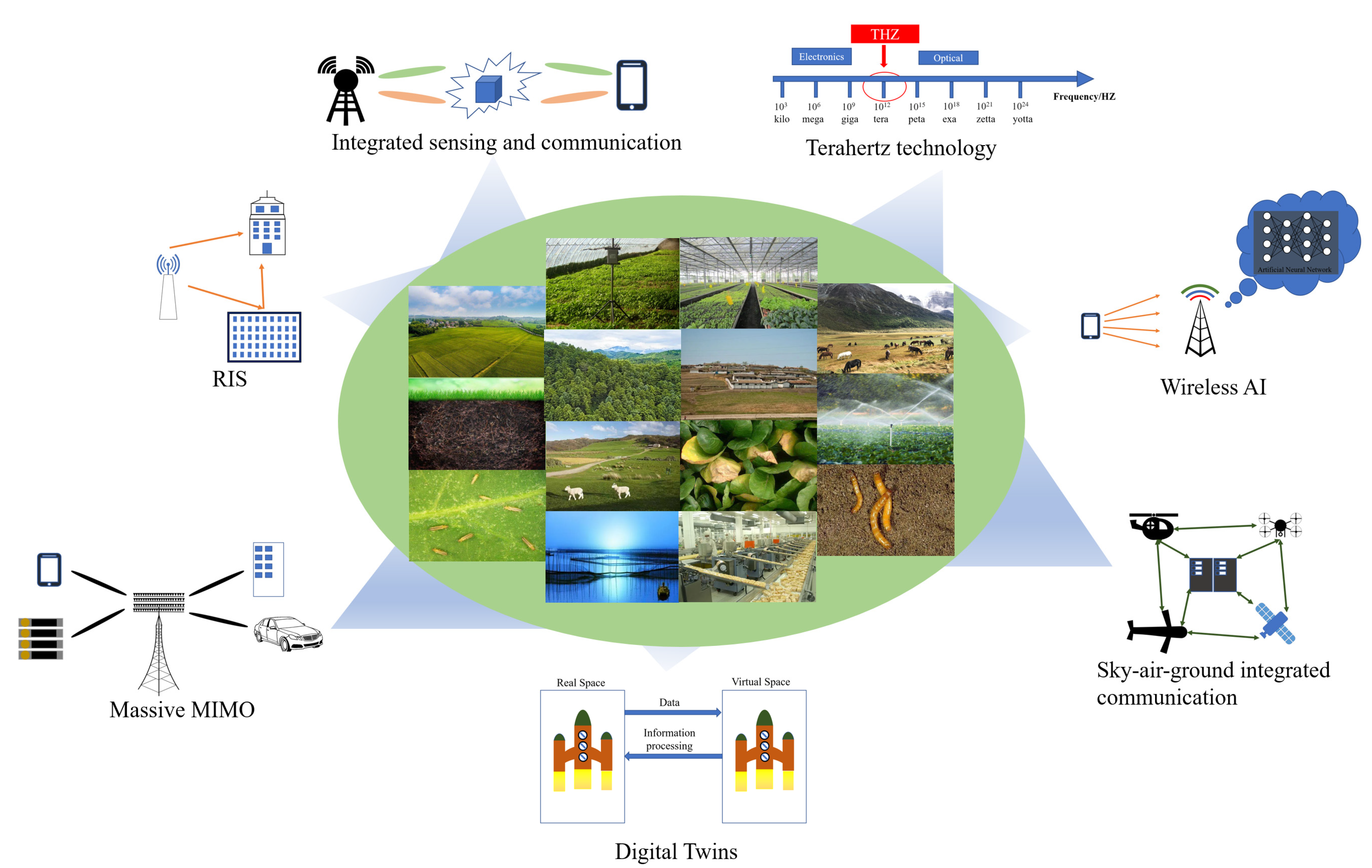
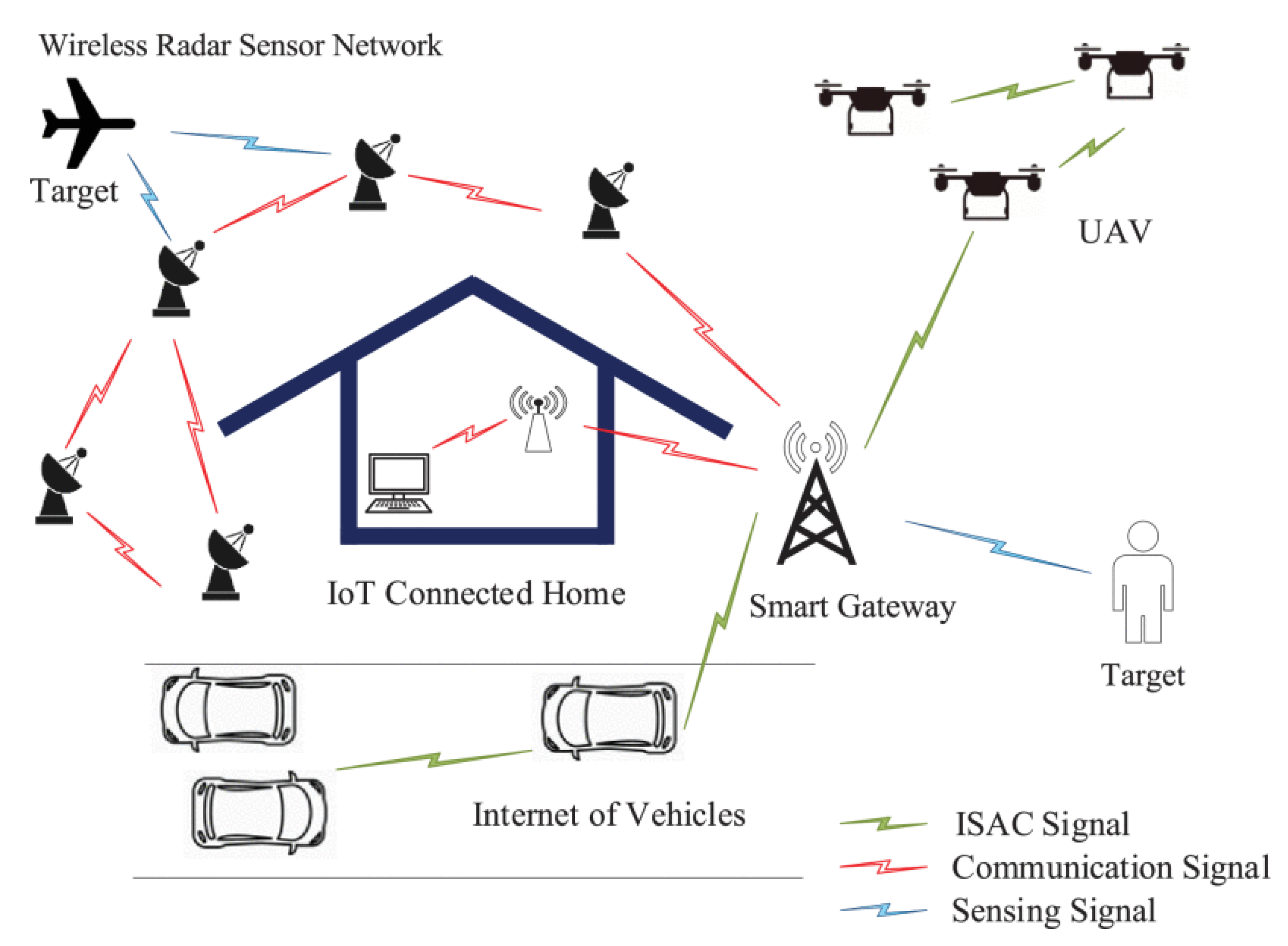
| Name | Low Costs | Low Power Consumption | Easy Deployment | Information Transmission Distance | Information Transmission Rate | Operating Frequency Bands | Specific Application Cases |
|---|---|---|---|---|---|---|---|
| ZigBee | √ | √ | √ | 10~100 m | 20~250 Kb/s | Global Band: 2.4 GHz European Band: 868 MHz North American Band: 915 MHz | Environmental monitoring in Qiongzhou University Botanical Garden, Hainan Province [10]; smart irrigation in southern Algeria [11]; and decertation monitoring in Brazilian farmland [12]. |
| LoRa | √ | √ | √ | 2~15 km | 10~220 Kb/s | European Union: 868 MHz North America: 915 MHz China: 783 MHz | Environmental monitoring of vineyards on the UTAD University campus [13]; tree growth status monitoring in tree plantations in Indiana, USA [14]; and an intelligent irrigation system applied in Indian farmland [15]. |
| Wi-Fi | √ | √ | √ | 5~300 m | 125 Kb/s~4 Gb/s | 2.4 GHz, 5 GHz, 6 GHz | Providing communication services for the countries in Ghana [16]; soil salinity monitoring in Suntai and Dongxin [17]; and intelligent irrigation systems applied in the semi-arid region of southeastern Spain (Murcia region) [18]. |
| Bluetooth | √ | √ | √ | 8~30 m | 100 Kb~50 Mb/s | 2.4 GHz | Smart seeders deployed in Indian farmland [19]; wireless sensor networks for crop growth monitoring by agronomists in Ukraine [20]; and wireless sensor networks for cattle behavior monitoring in Romania [21]. |
| Name | Features | Existing or Potential Applications | Limitations and Challenges |
|---|---|---|---|
| Space–air–ground-integrated networks | Integration of ground-based, air-based, and space-based networks. Providing large coverage, high throughput, and strong resilience. | Enhancing farm management. Forest protection. Supporting communication in remote areas. | Infrastructure cost for drones, satellites, and base stations in agricultural scenario needs further investigation. |
| Terahertz technology | Wide bandwidth, low latency, high transmission rate, strong penetration, and high sensitivity. | Pesticide residue monitoring. Plant nutrition monitoring. Grain quality monitoring. Weather forecasting. | A terahertz wave attenuates very quickly, and so the coverage area is restricted. A large-scale farm is a challenging scenario for its application. |
| RIS | Low cost, low energy consumption, programmable, easy to deploy, and intelligent reconfiguration of the wireless propagation environment. | Enhancing agricultural communication networks in terms of coverage and energy efficiency. Enhancing precision agricultural sensing. | RIS is currently not industrialized. Therefore, it still requires experiments and evaluation for its application in various agricultural activities. |
| Wireless AI | Global optimization for multi-models and end-to-end communications. Efficient approximation and fitment for arbitrary complex systems. Continuous self-adjustment/evolution/repairment in a variety of scenarios and applications. | AI-based agricultural sensing network design. Resource management for agricultural networks. AI-based wireless sensing for agricultural activities. | In the current agricultural applications, AI and wireless communication technology are simply combined together, and there is no actual improvement of wireless communication performance by utilizing AI. |
| Integrated sensing and communication | Integration of sensing and communication functions. High efficiency of spectrum/hardware utilization and information processing. | Millimeter wave-based ISAC systems for the prevention of plant diseases/infestations and for dairy farming. ISAC with space–air–ground-integrated networks for forest protection. | It is still in the design stage for prototypes and is not standardized and industrialized. The complex environment in some agricultural scenarios may simultaneously degrade its communication and sensing performance. |
| Massive MIMO | Ultra-large antenna arrays and higher spectral efficiency, supporting more flexible network architecture. | Supporting agricultural IoT for large-scale and complex agricultural activities. Enhancing space–air–ground-integrated communication networks for agriculture. Precision agricultural sensing, e.g., earthquake prediction and accurate harvesting. | The complexity of massive MIMO deployments increases rapidly with the number of antennas and users, making its hardware requirements high. Hardware impairment and pilot contamination are issues that should be carefully handled. |
| Digital twins | Digital replicas of actual physical systems. Enabling high-level control of physical entities. Management of complex systems. | Conditioning for plant growth. Greenhouse environment settings. Design of novel agricultural systems. | There is a lack of standard reference for the research and implementation of key digital twin technologies in agriculture, which leads to poor compatibility and interaction between products developed by different digital twin teams and makes data integration difficult. |
| Ambient backscatter communications | Low energy, low cost, easy to deploy, and mature development. | Plant leaf moisture monitoring Greenhouse temperature monitoring UAV communication performance improvement | The transmission range of backscatter communication is limited. It is not suitable for long distance communication and large-scale sensing. |
Publisher’s Note: MDPI stays neutral with regard to jurisdictional claims in published maps and institutional affiliations. |
© 2022 by the authors. Licensee MDPI, Basel, Switzerland. This article is an open access article distributed under the terms and conditions of the Creative Commons Attribution (CC BY) license (https://creativecommons.org/licenses/by/4.0/).
Share and Cite
Zhang, F.; Zhang, Y.; Lu, W.; Gao, Y.; Gong, Y.; Cao, J. 6G-Enabled Smart Agriculture: A Review and Prospect. Electronics 2022, 11, 2845. https://doi.org/10.3390/electronics11182845
Zhang F, Zhang Y, Lu W, Gao Y, Gong Y, Cao J. 6G-Enabled Smart Agriculture: A Review and Prospect. Electronics. 2022; 11(18):2845. https://doi.org/10.3390/electronics11182845
Chicago/Turabian StyleZhang, Fan, Yu Zhang, Weidang Lu, Yuan Gao, Yi Gong, and Jiang Cao. 2022. "6G-Enabled Smart Agriculture: A Review and Prospect" Electronics 11, no. 18: 2845. https://doi.org/10.3390/electronics11182845
APA StyleZhang, F., Zhang, Y., Lu, W., Gao, Y., Gong, Y., & Cao, J. (2022). 6G-Enabled Smart Agriculture: A Review and Prospect. Electronics, 11(18), 2845. https://doi.org/10.3390/electronics11182845












